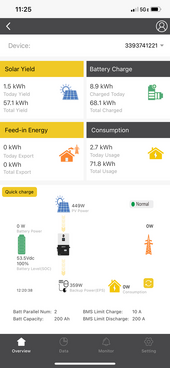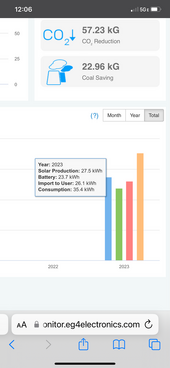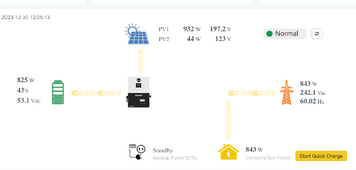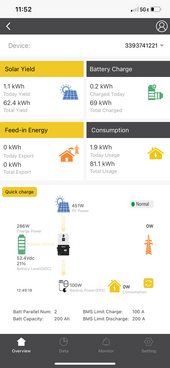There's no "easy button" option to tell it to go to bypass mode manually. I just play with the options & thresholds to get it to do what I want. Try this combination:
- Enable battery ECO mode
- Set your AC Charge Start Battery SOC(%) to lower than your current battery charge - say like 15%
- In the discharge setting section, set your On Grid EOD SOC(%) to lower than your current battery charge but higher than the AC Charge Start Battery SOC - say like 20%.
Using the configuration example above, it should switch the unit to grid bypass mode - pulling exactly the power from the grid only what is demanded by the loads, with solar continuing to charge your batteries. If you leave it at those settings, once the batteries get to 30%, it will switch back to running the loads off the inverter with solar and battery power until the battery gets down to 20% again. Note that having the On Grid EOD SOC set higher than the AC Charge Start Battery SOC means the batteries shouldn't ever get lower than the On Grid EOD SOC - meaning you would never actually use the grid for charging - only solar. If you are like me and want to minimize what you pull from the grid, that's ideal.
BTW - once it's in bypass mode, if you want to let the batteries charge more than 10% more before switching to the inverter, you can raise the On Grid EOD SOC threshold to higher (like 80%) and the unit will stay in bypass mode until the batteries get up to 10% higher than the threshold (90% in this example). I'm only doing this exercise this time of year where my solar panels are so shaded that it is taking multiple days to fully charge my batteries, so I only change the threshold every 3-4 days. Once the shade goes away later in the year I plan to leave my On-Grid EOD SOC setting to be relatively low - like 20% - and just leave it there as the batteries will fully charge each day and only get down to like 40% overnight before charging from solar again and never pull any power from the grid for charging or for bypass.
I hope this is making sense. Maybe it sounds confusing but it's what is working for me during this time of year. Otherwise, with not enough solar coming in to cover my loads and charge the batteries enough to get through the night, keeping the batteries charged with AC input was actually consuming more power because of efficiency losses than my loads were consuming - so I was actually losing money vs just running my loads from the grid. At least in this way I only use from the grid exactly what my loads consume until after 3-4 days my batteries are charged and switch the unit to inverter mode and I get one battery cycle worth of grid savings for the day.
I'm just hoping EG4 actually adds a second threshold like I suggested to them to give a corresponding threshold to the On Grid EOD SOC - like an On Grid Start of Discharge setting so I wouldn't need to change the On Grid EOD SOC setting every 3-4 days.










